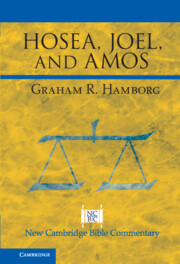Book contents
II - Book of Hosea
Published online by Cambridge University Press: 15 June 2023
Summary
The Introduction draws attention to the many pictures and metaphors employed in the text. Literary study of the text reveals three sections: Chapters 1–3, 4–11, 12–14. Redaction-critical study indicates that the text developed from an earliest eighth-century text into the final form produced in the post-exilic period. Chapters 1–3 contain narrative material and prophetic sayings concerning Hosea’s marriage. Chapters 4–11 and 12–14 contain prophetic words of judgment and restoration. Key themes include Israel’s unfaithfulness to YHWH, of which the people’s worship of Baal and the nation’s propensity to seek alliances with Assyria and Egypt (rather than seeking YHWH) are indicative. There are Closer Look sections (A Wife of Prostitution; Baalism, Canaanite Religion and Ancient Ugarit; Knowledge of and by YHWH; Hosea and the Ten Commandments; Ephraim in Hosea; The Covenant in Scholarly Research; Jacob in Hosea 12). There are also Bridging the Horizons sections (The Metaphor of the Unfaithful Wife; Priestly Responsibility; Israel’s Alliances with Foreign Nations; The Judgment and Mercy of YHWH).
- Type
- Chapter
- Information
- Hosea, Joel, and Amos , pp. 16 - 188Publisher: Cambridge University PressPrint publication year: 2023



